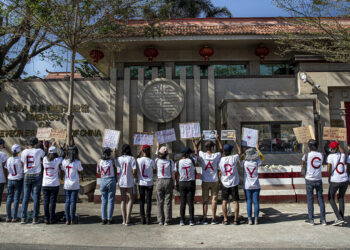RANGOON — The Burmese government has asked United Wa State Army (UWSA) members to withdraw their troops, citing a push for greater stability in the Mongla region of eastern Shan State, according to a senior officer from the National Democratic Alliance Army (NDAA), which controls the enclave on the Chinese border.
Some 1,000 members of the UWSA took some key mountains posts from the NDAA earlier in October, reportedly a preventative measure against a potential offensive from the Burma Army; previously, the NDAA controlled all roadside posts in the area, which is designated Shan State Special Region 4. Now, some of these posts are blocked—locals recently reported not being able to pass from Mongla to the eastern Shan State administrative capital of Kengtung.
Amid high tension in the region, Kyi Myint, a leader within the NDAA (more popularly known as the Mongla Group) told The Irrawaddy on Monday that the National Reconciliation and Peace Centre (NRPC)’s Dr. Tin Myo Win asked the UWSA—by letter—to consider withdrawing their troops from the area and even requested a meeting with the group in Mongla to discuss the issue. The UWSA, however, refused the meeting, Kyi Myint said.
“We have welcomed the NRPC to come for any amount of time to our Mongla area. But, the Wa told them in their letter not to come,” said Kyi Myint.
Leaders from the NDAA have also asked the UWSA to withdraw their troops from the area as there are worries that fighting could break out in the region with the Burma Army. Members of the UWSA said that they would only withdraw their troops after receiving orders to do so from their own senior officers, said the Kyi Myint.
Rumors have spread locally that the Burma Army might launch an offensive in the Mongla region if UWSA members refuse to leave.
“A lot of our people are scared. They should withdraw their troops in order to have stability in our region. Their action was a mistake. We do not want to have a military offensive, gunfire and artillery. We just wanted our people to have peace and be happy,” said Kyi Myint.
The UWSA and NDAA are longtime allies; both groups sprang out of units of the Communist Party of Burma when it imploded in 1989, and signed ceasefires with the Burmese government more than 25 years ago. Relations with the Burma Army have been peaceful ever since.
A divide between the two groups became visible concerning the 21st Century Panglong peace conference hosted in Napyidaw in late August and early September. The NDAA agreed to continue to engage in the peace process led by State Counselor Daw Aung San Suu Kyi, but the UWSA delegation left the conference early, citing unequal treatment.
“For us, we will keep supporting the peace process. This is our stand,” said Kyi Myint of the NDAA.
The UWSA commands 30,000 troops by some estimates, making it the largest non-state armed group in Burma. The group’s territory borders that of the Burma Army in three eastern and southern Shan State locations: Tang Yan, Chin Shwe Hall, and Loi Tak.
Large UWSA bases near these “borders” could contribute to the severity of fighting, were it to break out, explained ethnic affairs commentator U Maung Maung Soe.
“It would be a lot better if they could avoid fighting breaking out,” he said, in reference to the Burmese government forces. “If they let it break out, it would quickly spread.”

















